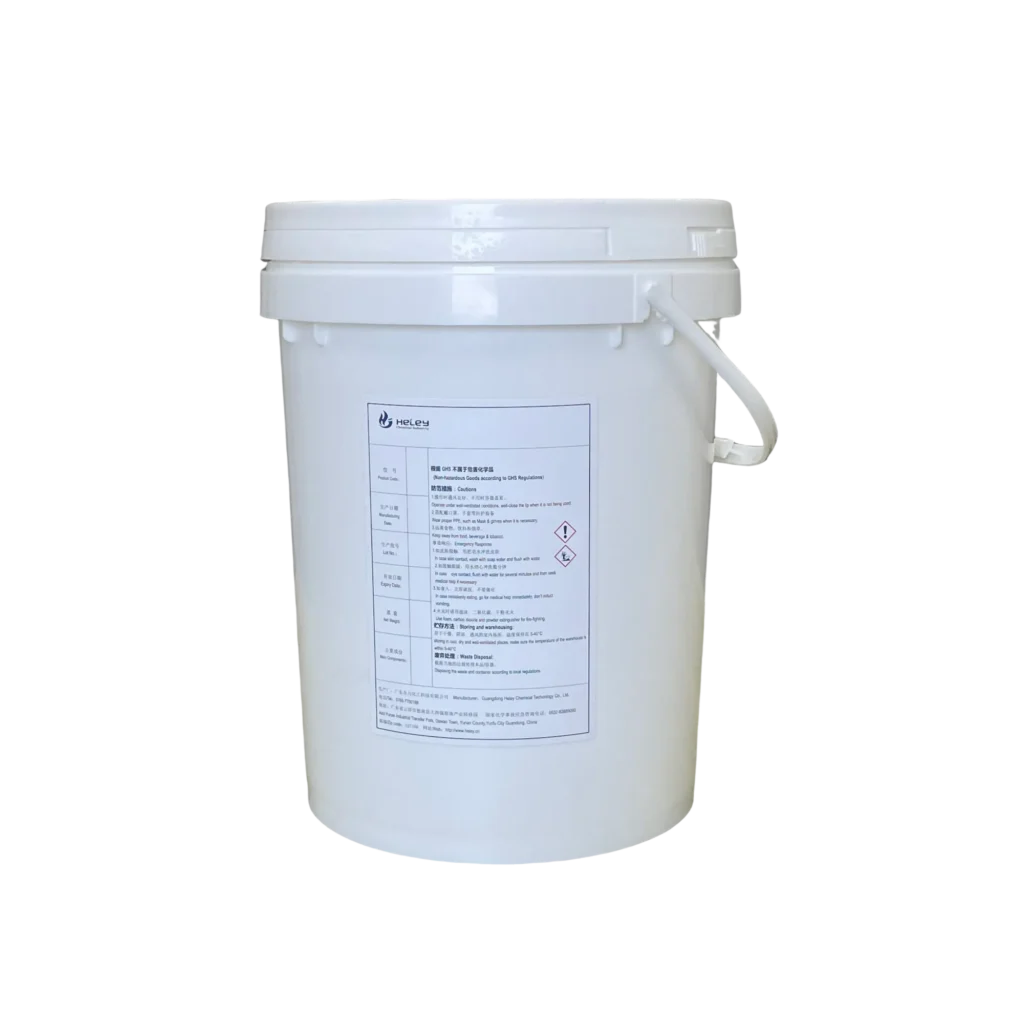
পানি-ভিত্তিক পলিউরেথেন (PU) আঠালো হল একটি পরিবেশ বান্ধব বিকল্প যা প্রচলিত দ্রাবক-ভিত্তিক PU আঠালোর পরিবর্তে ব্যবহৃত হয়। এই আঠালোগুলি পানি ব্যবহার করে পরিবহন হিসেবে, যা ক্ষতিকারক দ্রাবকগুলির ব্যবহার কমায় এবং ভোলাটাইল অর্গানিক কম্পাউন্ড (VOC) নির্গমন হ্রাস করে। পানি-ভিত্তিক PU আঠালো প্রস্তাব করে চমৎকার আঠালো শক্তি এবং নমনীয়তা, যা পরিবেশগত প্রভাব এবং কর্মক্ষমতা উভয়ই গুরুত্বপূর্ণ যেখানে তা প্রয়োগ করা হয়। এটি ব্যাপকভাবে ফুটওয়্যার শিল্প, প্যাকেজিং, অটোমোটিভ অভ্যন্তরীণ এবং সাধারণ নির্মাণে ব্যবহৃত হয়, যা বিভিন্ন উপকরণকে একত্রিত করার জন্য একটি নিরাপদ এবং কার্যকরী সমাধান প্রদান করে।
কেমিক্যাল কম্পোজিশন: পানি-প্রসারিত পলিউরেথেন রেজিন দ্বারা প্রস্তুত, যা উচ্চ নমনীয়তা এবং শক্তিশালী আঠালো ক্ষমতা প্রদান করে।
শুকানোর সময়: প্রাথমিক সেটিং সময় সাধারণত ১০-২০ মিনিট হয়, পুরো শুকানোর প্রক্রিয়া সাধারণত ২৪ ঘণ্টার মধ্যে সম্পন্ন হয়, তাপমাত্রা এবং আর্দ্রতার উপর নির্ভর করে।
ভিস্কোসিটি: মাঝারি ভিস্কোসিটি, যা ব্রাশ, রোলার বা স্প্রে সিস্টেম দিয়ে প্রয়োগের জন্য উপযুক্ত, যাতে পৃষ্ঠতলে সহজে ছড়িয়ে পড়ে।
তাপমাত্রা প্রতিরোধ: -১০°C থেকে ৮০°C তাপমাত্রার মধ্যে কর্মক্ষমতা বজায় রাখে, যা অভ্যন্তরীণ এবং বাইরের ব্যবহারের জন্য উপযুক্ত, কিছু ফর্মুলেশন উন্নত তাপ প্রতিরোধ প্রদান করে।
স্টোরেজ লাইফ: সঠিকভাবে ঠান্ডা এবং সিল করা কন্টেইনারে সংরক্ষণ করলে প্রায় ৯-১২ মাস।
বিশেষ ব্যবহারের ক্ষেত্রে: ফুটওয়্যার উৎপাদনে চামড়া, কাপড় এবং রাবার সংযুক্ত করার জন্য আদর্শ, যার মধ্যে সোল এবং আপার সংযুক্ত করা এবং আসবাবপত্র এবং ফোমের আঠালো সম্পর্কিত কাজ।
শিল্প ব্যবহার: ফুটওয়্যার শিল্প, প্যাকেজিং, অটোমোটিভ অভ্যন্তরীণ অ্যাসেম্বলি এবং আসবাবপত্র উৎপাদনে সাধারণত ব্যবহৃত হয়, বিশেষ করে যেখানে VOC বিধিমালা কঠোর।
উপকরণের সামঞ্জস্য: চামড়া, কাপড়, ফোম, কাঠ, রাবার এবং কিছু প্লাস্টিকের সাথে কার্যকরভাবে আঠালো যোগায়, যা বিভিন্ন অ্যাপ্লিকেশনগুলিতে বিস্তৃত ব্যবহারের সুযোগ প্রদান করে।
ইকো-ফ্রেন্ডলি: পানি-ভিত্তিক ফর্মুলেশনটি VOC নির্গমন উল্লেখযোগ্যভাবে কমায়, যা এটি ব্যবহারকারী এবং পরিবেশের জন্য নিরাপদ করে এবং কঠোর বায়ু গুণমান বিধিমালার সাথে সামঞ্জস্যপূর্ণ।
শক্তিশালী আঠালো: প্রাথমিক ট্যাক এবং শক্তিশালী চূড়ান্ত আঠালো শক্তি প্রদান করে, যা একত্রিত উপকরণের মধ্যে দীর্ঘস্থায়ী স্থায়িত্ব নিশ্চিত করে।
নমনীয়: কিউরিংয়ের পরে নমনীয়তা ধরে রাখে, এটি এমন অ্যাপ্লিকেশনের জন্য আদর্শ যেখানে আঠালো উপকরণগুলি নমনীয় বা চলাচল করতে হয়, যেমন জুতা এবং আসবাবপত্র।
কম গন্ধ: পানি-ভিত্তিক কম্পোজিশনের কারণে দ্রাবকভিত্তিক আঠালো তুলনায় অল্প গন্ধ থাকে, যা এটি সঙ্কীর্ণ স্থানগুলিতে কাজ করার সময় আরও আরামদায়ক করে তোলে।
সহজ পরিষ্কার: নিরাময়ের আগে জল দিয়ে পরিষ্কার করা যেতে পারে, সরঞ্জাম এবং কাজের ক্ষেত্রগুলি পরিষ্কার করার সময় কঠোর দ্রাবকগুলির প্রয়োজনীয়তা হ্রাস করে।
পৃষ্ঠ প্রস্তুতি: আঠালো সংযুক্ত করার আগে পৃষ্ঠগুলিকে পরিষ্কার করুন, যাতে কোন ধূলিকণা, তেল বা দূষণকারী উপাদান না থাকে এবং উপযুক্ত আঠালো শক্তি নিশ্চিত করা যায়।
আঠালো প্রয়োগ: ব্রাশ, রোলার বা স্প্রে সিস্টেম ব্যবহার করে, এক বা উভয় পৃষ্ঠে পানি-ভিত্তিক PU আঠালো একটি সমান স্তর প্রয়োগ করুন।
খোলার সময়: আঠালো ৫-১০ মিনিট অপেক্ষা করতে দিন, আর্দ্রতা এবং তাপমাত্রার উপর নির্ভর করে, যতক্ষণ না এটি ট্যাকি হয়ে যায়।
পৃষ্ঠ একত্রিত করা: পৃষ্ঠগুলিকে দৃঢ়ভাবে একত্রিত করুন, সমান চাপ প্রয়োগ করে একটি এককৃত আঠালো শক্তি নিশ্চিত করুন।
কিউরিং প্রক্রিয়া: আঠালোকে ২৪ ঘণ্টা পর্যন্ত রুম তাপমাত্রায় কিউর করতে দিন, সর্বাধিক আঠালো শক্তি অর্জনের জন্য, এর পরে একত্রিত আইটেমটি ভারী ব্যবহারে প্রয়োগ করুন।
নিরাপত্তা সতর্কতা: দ্রাবকভিত্তিক বিকল্পগুলির তুলনায় কম ঝুঁকিপূর্ণ হলেও, ত্বকের সংস্পর্শ এড়াতে গ্লাভস ব্যবহার করা এবং ব্যবহার শেষে হাত ভালোভাবে ধুয়ে ফেলা সুপারিশ করা হয়।
বায়ুচলাচল প্রয়োজনীয়তা: সঠিক শুকানোর জন্য একটি ভালো বায়ুচলাচলযুক্ত এলাকায় প্রয়োগ করুন, বিশেষ করে যখন এটি বড় পরিমাণে ব্যবহৃত হয়।
নির্বাহ নির্দেশিকা: আঠালো বর্জ্য স্থানীয় পরিবেশগত বিধিমালার অধীনে নিষ্পত্তি করুন। আঠালো এখনও ভিজে থাকলে স্পিল পরিষ্কার করতে পানি ব্যবহার করুন।
স্টোরেজ নির্দেশিকা: ঠান্ডা, শুষ্ক স্থানে সংরক্ষণ করুন এবং কন্টেইনারটি সিল করে রাখুন যাতে আঠালো শুকিয়ে না যায় বা দূষিত না হয়।
টেকসই উদ্যোগ: পানি-ভিত্তিক PU আঠালো পরিবেশগত প্রভাব কমানোর জন্য প্রস্তুত করা হয়েছে, যা প্রচলিত দ্রাবক-ভিত্তিক আঠালোর তুলনায় উল্লেখযোগ্যভাবে কম VOC পরিমাণ রাখে।
পুনর্ব্যবহারযোগ্যতা: পুনর্ব্যবহারযোগ্য কন্টেইনারে প্যাকেজ করা হয়েছে, যা পরিবেশবান্ধব নিষ্পত্তি প্রক্রিয়া সমর্থন করে।
নন-টক্সিক ফর্মুলাস: কিছু ফর্মুলেশন জীববাহিত উপাদান ব্যবহার করে, যা ব্যবহারকারী এবং পরিবেশের জন্য নিরাপদ করে তোলে।
সমস্যা: আঠালো শুকানোর জন্য খুব বেশি সময় নিচ্ছে।
সমাধান: শুকানোর প্রক্রিয়া ত্বরান্বিত করতে বায়ুচলাচল বৃদ্ধি করুন অথবা ফ্যানের মতো তাপ উৎস ব্যবহার করুন।
সমস্যা: কিউরিংয়ের পর দুর্বল আঠালো শক্তি।
সমাধান: আঠালো প্রয়োগের আগে নিশ্চিত করুন যে পৃষ্ঠগুলি পরিষ্কার এবং শুকানো আছে এবং আঠালো প্রয়োগের সময় পর্যাপ্ত চাপ প্রয়োগ করা হয়েছে।
সমস্যা: আঠালো কন্টেইনারে ঘন হয়ে গেছে।
সমাধান: একটি ঠান্ডা, সামঞ্জস্যপূর্ণ তাপমাত্রার পরিবেশে সংরক্ষণ করুন এবং প্রতিবার ব্যবহার করার পরে কন্টেইনারটি সিল করে রাখুন যাতে বাষ্পীভবন প্রতিরোধ করা যায়।
পাদুকা উৎপাদনে সাধারণ আঠালোগুলি হল PU আঠালো, গ্রাফটেড আঠালো, ক্লোরোপ্রিন আঠালো, স্প্রে আঠালো এবং সিনথেটিক রাবার আঠালো, প্রতিটি নির্দিষ্ট অ্যাপ্লিকেশনের জন্য উপযুক্ত।
পাদুকা উপাদান যেমন চামড়া, কাপড়, বা রাবারের সাথে সামঞ্জস্য বিবেচনা করে আঠালো নির্বাচন করুন, নমনীয়তা এবং টেকসইতার মতো উপাদানগুলি বিবেচনায় নিয়ে। আরও বিস্তারিত জানার জন্য আপনি আমাদের দলের সাথে যোগাযোগ করতে পারেন।
সলভেন্ট-ভিত্তিক আঠালো শক্তিশালী বন্ধন এবং দ্রুত শুকানোর সময় প্রদান করে, যখন পানি-ভিত্তিক আঠালো পরিবেশ বান্ধব এবং পরিষ্কার করা সহজ।
বিভিন্ন জলবায়ু বা তাপমাত্রায় আঠালো কর্মক্ষমতা কীভাবে পরিবর্তিত হয়?
নিরাপত্তা সতর্কতায় অন্তর্ভুক্ত থাকে একটি ভাল বায়ু চলাচলযুক্ত এলাকায় কাজ করা, গ্লাভস এবং মাস্ক পরা, এবং প্রস্তুতকারকের নির্দেশিকা অনুসরণ করা।
পাদুকা আঠালোদের শেলফ লাইফ সাধারণত ৬ মাস থেকে ২ বছর পর্যন্ত হয়, এটি সংরক্ষণের শর্ত এবং ফর্মুলেশনের উপর নির্ভর করে।
যদি আপনি কাস্টমাইজড পণ্য বা প্রযুক্তিগত সহায়তা প্রয়োজন, তাহলে নিচের বোতামে ক্লিক করুন। আমাদের বিশেষজ্ঞ ২৪ ঘন্টার মধ্যে আপনার কাছে ফিরে আসবে।


